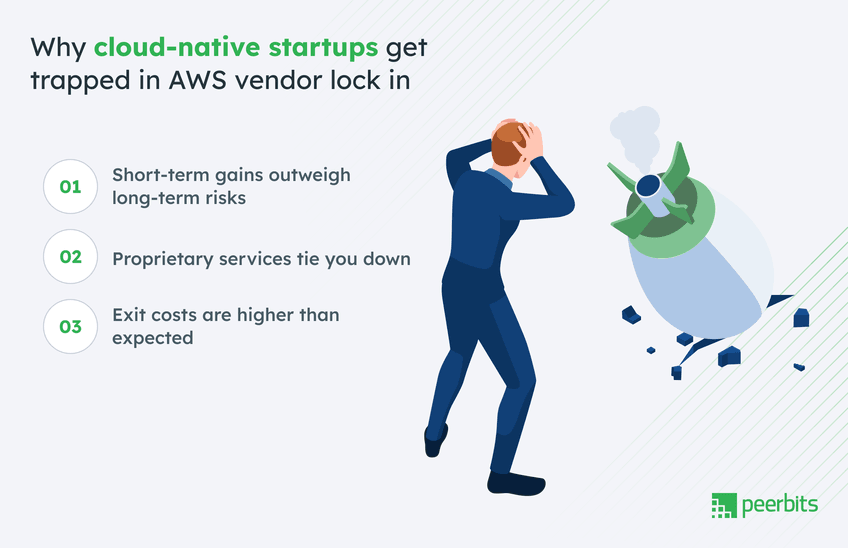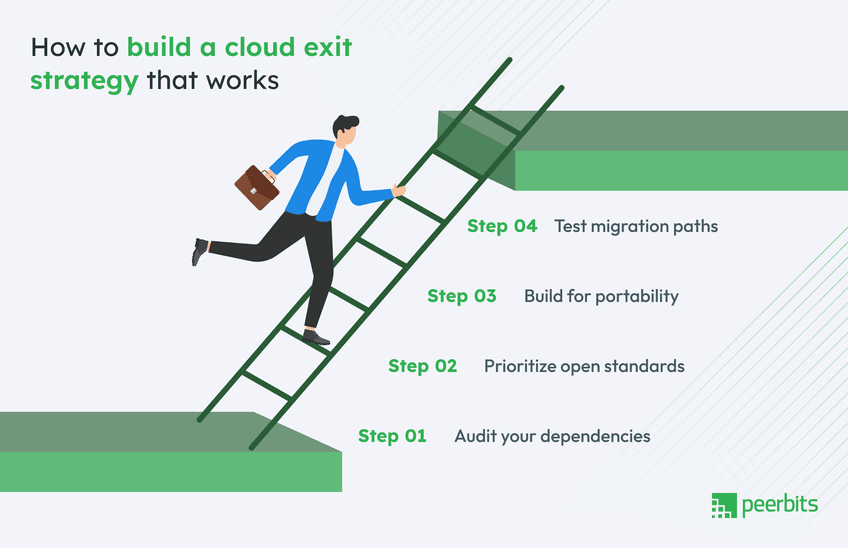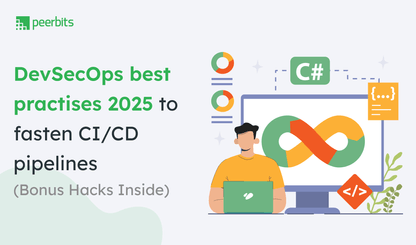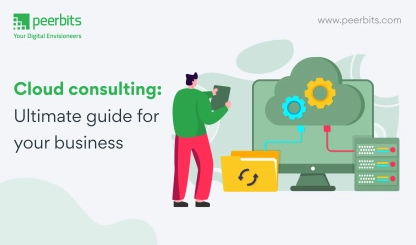Every startup loves speed. The faster you can launch, the sooner you can validate your product. For cloud-native startups, AWS looks like the safest bet. It has everything under one roof: storage, compute, machine learning APIs, databases, and managed services that save time.
But the same convenience is often the reason many startups later feel trapped. Once the business depends too heavily on AWS, the cost and complexity of leaving or even expanding into another provider can be overwhelming.
This is the heart of the AWS vendor lock-in problem. The more you grow inside AWS, the harder it gets to move away. Let’s look closer at why this happens and how smart startups prepare exit strategies without slowing down innovation.
Why startups fall into AWS vendor lock-in
AWS offers an ecosystem that feels like an accelerator for cloud-native development. Services like Lambda, DynamoDB, and S3 are tightly integrated. Founders love this because it shortens release cycles. But the deeper you architect around AWS cloud native services, the more your infrastructure becomes designed only for AWS.

Startups fall into this pattern for three main reasons:
1. Short-term gains outweigh long-term risks
Early-stage startups prioritize shipping features fast. AWS cloud computing services make this possible, but they often skip the long-term implications. What looks like a time-saver today becomes a barrier when you want flexibility tomorrow.
2. Proprietary services tie you down
Using AWS-specific databases, message queues, or APIs creates dependencies. Switching away means rewriting core parts of the application, which is costly. This is where the risk of vendor lock-in in cloud computing really shows.
3. Exit costs are higher than expected
Once workloads scale, the data transfer charges, migration complexity, and re-engineering effort make moving out of AWS extremely expensive. Many startups don’t factor this into their early AWS migration strategy.
These challenges pile up over time, making it harder for cloud-native startups to think beyond AWS. But being locked in is not the only path.
Hidden costs of AWS vendor lock-in
Lock-in doesn’t just restrict choice; it impacts growth, budgets, and innovation.
- Limited bargaining power: You can’t negotiate better pricing when AWS knows you can’t move easily.
- Innovation issues: When you depend on AWS-exclusive services, adopting cutting-edge tools outside their ecosystem becomes complicated.
- Regulatory risks: Some industries require multi-region or multi-vendor compliance. Heavy dependence on AWS cloud architecture services makes this harder.
- Operational complexity: Migrating later adds delays, disrupts releases, and drains developer focus.
Put simply, vendor lock-in can stall your startup at the very stage when agility matters most.
Smarter paths to avoid vendor lock-in
The good news is startups can protect themselves without giving up AWS completely. Think of it as balancing short-term speed with long-term flexibility. Here are strategies cloud-native startups are using:
Multi-cloud strategies for flexibility
A multi cloud strategy means running workloads across AWS, Azure, or Google Cloud. This avoids reliance on a single provider. With multi cloud management platforms, you can spread risk while still using AWS cloud computing services where they work best.
Practical example: Keep your databases in Google Cloud, analytics in AWS, and identity management in Azure. This way, moving one component doesn’t break the entire system.
Hybrid cloud adoption
Some startups combine public clouds like AWS with private or on-prem setups. Hybrid cloud adoption helps startups comply with regulations, handle sensitive data securely, and avoid being trapped in a single provider’s ecosystem.
Open-source cloud tools
Kubernetes, Terraform, and OpenShift are lifesavers here. They reduce the dependency on proprietary services by providing standardized orchestration and deployment. Architecting for the cloud with open-source tools means you can replicate workloads across providers with less effort.
By weaving these strategies into your architecture early, you avoid painful rework later.
How to design a cloud exit strategy

A cloud exit strategy is not about abandoning AWS completely. It’s about giving yourself options. Startups that plan this early find it easier to pivot when business needs change.
Step 1: Audit your dependencies
Identify which AWS services are critical. Ask yourself: Can this workload run on another provider? If not, how much effort would it take to make it portable?
Step 2: Prioritize open standards
Whenever possible, use technologies that aren’t tied to AWS. For example, PostgreSQL instead of DynamoDB, or Kubernetes instead of ECS. This reduces AWS vendor lock-in challenges later.
Step 3: Build for portability
Use containers and Infrastructure as Code. It makes your AWS migration strategy simpler when workloads need to shift.
Step 4: Test migration paths
Don’t wait until you’re forced to migrate. Run periodic tests where you deploy a service in a second cloud. This validates your exit plan before it becomes urgent.
This way, a cloud exit strategy feels less like a backup plan and more like an ongoing business safeguard.
Common mistakes startups make
Even with good intentions, startups often misstep when trying to avoid vendor lock in.
- Overengineering too early: Building complex multi-cloud setups before product-market fit wastes resources. Balance is key.
- Ignoring data gravity: Moving massive datasets across providers is expensive. Plan storage decisions carefully.
- Relying on comfort zones: Teams stick with AWS cloud native services because they’re familiar, even if it means losing flexibility.
- Delaying planning: The later you think about a cloud exit strategy, the more painful it gets.
Recognizing these mistakes helps founders course-correct before vendor lock-in becomes a major barrier.
Practical AWS migration strategy examples
Some real-world cases highlight how startups navigate these challenges:
- Case A: Analytics startup
They relied heavily on AWS Athena and Redshift. To reduce vendor lock-in, they shifted some workloads to Snowflake, which works across cloud providers. Their AWS migration strategy involved gradual data replication instead of a sudden switch.
- Case B: SaaS platform for healthcare
This company adopted hybrid cloud adoption, keeping patient data in a private environment while running front-end services on AWS. It satisfied compliance rules and avoided total dependence on AWS cloud architecture services.
- Case C: AI-driven fintech app
They built their ML pipelines with open-source cloud tools like Kubeflow and TensorFlow. This made their architecture portable across AWS, Azure, and GCP, minimizing the risk of vendor lock-in in cloud computing.
These examples show that exit strategies are not about abandoning AWS. They’re about building safety nets that give startups room to grow.
Looking ahead: cloud-native without the chains
Let’s be honest, AWS isn’t going anywhere. It will continue to be a dominant force in cloud computing. For cloud-native startups, it’s often the fastest launchpad. But the danger is in forgetting the long game. Building entirely around AWS cloud native services can box you in later when business needs shift.
Avoiding AWS vendor lock-in isn’t about fear; it’s about control. With open-source tools, multi cloud strategies, and hybrid cloud adoption, startups can keep options open. A thoughtful cloud exit strategy lets you use AWS where it shines while avoiding the pain of being trapped.
Startups that plan for flexibility early will find themselves better prepared for acquisitions, regulatory shifts, or new opportunities. Those who ignore it may end up tied to contracts and architectures they no longer control.
The choice is clear: build fast, but also build free.
Conclusion
AWS gives startups speed. But speed without flexibility can become a trap. Architecting for the cloud with portability in mind, experimenting with multi cloud management, and relying on open-source cloud tools keeps you ahead.
If your startup is already feeling the weight of AWS vendor lock-in, now is the time to rethink. Exit strategies aren’t about leaving; they’re about keeping the door open.
Stuck too deep in AWS?
Let our experts build you a flexible cloud exit strategy before costs spiral.
Talk to a consultant







